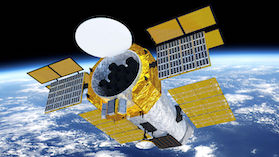HEASoft and XSPEC are now available as conda packages. See details ....
eXTP

 Mission Overview
Mission Overview
The enhanced X-ray Timing and Polarimetry mission (eXTP) is a future satellite designed to study extreme states of matter density, gravity, and magnetism. The program is to be led by the Chinese Academy of Sciences and universities in China, with partnerships with various European institutions. It is intended to be launched in 2027.
 Instrumentation
Instrumentation
eXTP will have a suite of X-ray imaging and non-image instruments. These include:
- the Spectroscopic Focusing Array (SFA), a set of 9 X-ray telescopes operating in the 0.5–10 keV energy band with a field-of-view (FoV) of 12′ each with an intended spatial resolution of 1′. The SFA will have an effective area of ∼0.8 m2 at 2 kev and 0.5 m2 at 6 keV. SFA will be equipped with Silicon Drift Detectors offering <180 eV spectral resolution. The optics are Wolter-I type nested mirrors with coated glass focal elements.
- the Polarimetry Focusing Array (PFA) consists of a set of 4 X-ray telescopes with an angular resolution of better than 30″ over a 12′ FoV, with a total effective area of 900 cm2 at 2 keV. It will be equipped with imaging gas pixel photoelectric polarimeters. PFA will be sensitve to energetic photons in the energy range 2–10 keV
- the Wide Field Monitor (WFM) will have 3 pairs of coded mask wide field units, equipped with position-sensitive Silicon Drift Detectors, covering in total a FoV of 3.7 sr (roughly 70° x 70°) sensitive to photons in the range 2–50 keV and spectral resolution of ∼300 eV at 6 keV, and an absolute timing accuracy of 1 µs. The two cameras in each pair are sensitive to location on one dimension, and only coarsely in the orthogoal direction, so mounted pairs are set at right angle orientations to provide accurate 2-D targeting for the pair. The positional accuracy should be 1′. The WFM will include on-board detection for bright events to trigger Burst Alerts.
- the Large Area Detector (LAD), a deployable set of 640 Silicon Drift Detectors (SDDs) with an effective area of ∼3.4 m2 between 6 and 10 keV. LAD will be senstive to 2–30 keV with a spectral resolution of <250 eV: bright events may be detectable up to 80 keV for magnetar flares and gamma-ray bursts. LAD will have 40 modules, each with 4 x 4 detectors and matching collimators, and should have a <1° FWHM field-of-view (FoV)
 Science
Science
eXTP will study ultra-dense matter in neutron stars, probing and exploring exotic matter states that exist in neutron stars because of intense gravitational fields. It will also explore the physics of strong magnetic fields in magnetars, accreting X-ray pulsars, and rotation-powered pulsars. eXTP is anticipated to discover a new magnetar candidate from flaring observations approximately once a year. The mission will also study the accretion processing in the strong-field limit of gravity around super-massive black holes seen at the core of active galactic nuclei.
